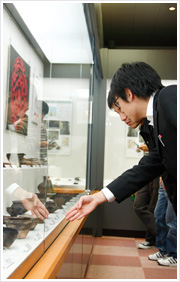Research Database
Archaeological Research Center For Northern Japan
 Kamegaoka Culture flourished from 3000-2300 B.C. during the late Jomon Period, and extended from the southwestern part of Hokkaido into the Tohoku Region. It was named after the Kamegaoka ruins found in Tsugaru City. Important features of Kamegaoka Culture are seen in such ritual artifacts as dogu (clay figures), doki (earthenware), and lacquerware. The shakokidogu (humanoid clay figures) are one of the most representative artifacts of the Kamegaoka Culture, and are so popular that they called “Shako-chan” throughout the Tsugaru area.
Kamegaoka Culture flourished from 3000-2300 B.C. during the late Jomon Period, and extended from the southwestern part of Hokkaido into the Tohoku Region. It was named after the Kamegaoka ruins found in Tsugaru City. Important features of Kamegaoka Culture are seen in such ritual artifacts as dogu (clay figures), doki (earthenware), and lacquerware. The shakokidogu (humanoid clay figures) are one of the most representative artifacts of the Kamegaoka Culture, and are so popular that they called “Shako-chan” throughout the Tsugaru area.
The Center was established in 2005 to participate in excavations and surveys of late Jomon sites in the area. It collects related materials and promotes the study of Kamegaoka Culture from an inter-disciplinary perspective. The Center also organizes exhibitions in order to make its research findings more accessible to the public and to stimulate regional cultural development. Seven professors of the Department of Cultural Assets, specializing in such fields as archaeology, cultural anthropology, history of art, and folklore, hold concurrent research positions in the Center. The Center also invites cultural heritage specialists from throughout Aomori Prefecture, thus strengthening regional cooperation.
Mini-Special exhibitions are held once a year in the exhibition room of the General Education Center building, where representative pieces of the Center collection are available for public viewing, not only to the students, staff and faculty of Hirosaki University but to the general public as well. The permanent exhibition of Archaeological Research Center For Northern Japan presents some of the university’s archaeological holdings. All visits to the Center must be booked in advance.
Materials collected by the Center include archeological artifacts “inherited” from Hirosaki Higher School (the predecessor to Hirosaki University) and the Funaki Tetsutaro Collection (Sakhalin, Russia), as well as artifacts excavated by the Hirosaki University Faculty of Humanities archaeological team at the Imazu ruins located in Sotogahama-machi and at the Sugisawa ruins in Sannohe-machi. The Center coordinates its activities with the educational activities of the Faculty of Humanities and the International Exchange Center as well as with the Curator Certification Program. Through their participation in Center activities, students not only come into first-hand contact with these archeological artifacts, but also learn how to value, protect and nurture them as cultural assets. Archaeological Research Center For Northern Japan successfully integrates education, research and outreach activities.
Events
①Mini-Special Exhibitions
・The World of the Kamegaoka Culture (2005)
・Kamegaoka Culture artifacts from Moriyoshi Mountain (2006)
・Jomon Culture as seen through the Narita Collection (2008)
②Excavation
・Sugisawa Ruins situated in Sannohe-machi, Sannohe-gun, Aomori (2006)
③Publications
・“Mini-Exhibition: The World of Kamegaoka Culture” Exhibition catalogue (2005)
・“List of Kamegaoka Culture Relics (2)” (2005)
・“List of Kamegaoka Culture Relics (3)” (2006)
・“Report on the Excavations at Sugisawa Ruins from Sannohe-machi, Sannohe-gun, Aomori” (2007)
・“A View on the Kamegaoka Culture” (2007)